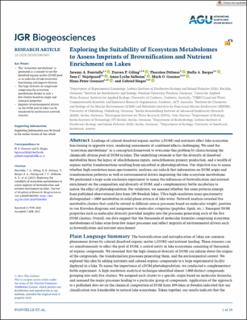| dc.contributor.author | Fonvielle, Jeremy A. | |
| dc.contributor.author | Giling, Darren P. | |
| dc.contributor.author | Dittmar, Thorsten | |
| dc.contributor.author | Berger, Stella Angela | |
| dc.contributor.author | Nejstgaard, Jens Christian | |
| dc.contributor.author | Solheim, Anne Lyche | |
| dc.contributor.author | Gessner, Mark O. | |
| dc.contributor.author | Grossart, Hans-Peter | |
| dc.contributor.author | Singer, Gabriel | |
| dc.date.accessioned | 2022-03-11T07:58:54Z | |
| dc.date.available | 2022-03-11T07:58:54Z | |
| dc.date.created | 2022-02-28T09:59:03Z | |
| dc.date.issued | 2021 | |
| dc.identifier.citation | Journal of Geophysical Research (JGR): Biogeosciences. 2021, 126 (5), e2020JG005. | en_US |
| dc.identifier.issn | 2169-8953 | |
| dc.identifier.uri | https://hdl.handle.net/11250/2984463 | |
| dc.description.abstract | Loadings of colored dissolved organic matter (cDOM) and nutrients affect lake ecosystem functioning in opposite ways, rendering assessments of combined effects challenging. We used the “ecosystem metabolome” as a conceptual framework to overcome this problem by characterizing the chemically diverse pool of DOM in lakes. The underlying rationale is that the diversity of dissolved metabolites bears the legacy of allochthonous inputs, autochthonous primary production, and a wealth of organic matter transformations resulting from microbial or photodegradation. Our objective was to assess whether high-resolution mass-spectrometric analyses can unlock that information on DOM origin and transformation pathways as well as environmental drivers imprinting the lake ecosystem metabolome. We performed a large-scale enclosure experiment to assess the influences of brownification and nutrient enrichment on the composition and diversity of DOM, and a complementary bottle incubation to isolate the effect of photodegradation. For validation, we assessed whether the same patterns emerge from published observational data from 109 Swedish lakes. Ultra-high-resolution mass spectrometry distinguished ∼3000 metabolites in solid-phase extracts of lake water. Network analysis revealed five metabolite clusters that could be related to different source processes based on molecular weight, position in van Krevelen diagrams and assignment to molecular categories (peptides, lipids, etc.). Emergent DOM properties such as molecular diversity provided insights into the processes generating each of the five DOM clusters. Overall, our data suggest that the thousands of molecular formulas comprising ecosystem metabolomes of lakes arise from few major processes and reflect imprints of environmental drivers such as brownification and nutrient enrichment. | en_US |
| dc.language.iso | eng | en_US |
| dc.publisher | Wiley | en_US |
| dc.rights | Navngivelse 4.0 Internasjonal | * |
| dc.rights.uri | http://creativecommons.org/licenses/by/4.0/deed.no | * |
| dc.title | Exploring the Suitability of Ecosystem Metabolomes to Assess Imprints of Brownification and Nutrient Enrichment on Lakes | en_US |
| dc.type | Peer reviewed | en_US |
| dc.type | Journal article | en_US |
| dc.description.version | publishedVersion | en_US |
| dc.rights.holder | © 2021. The Authors | en_US |
| dc.source.pagenumber | 19 | en_US |
| dc.source.volume | 126 | en_US |
| dc.source.journal | Journal of Geophysical Research (JGR): Biogeosciences | en_US |
| dc.source.issue | 5 | en_US |
| dc.identifier.doi | 10.1029/2020JG005903 | |
| dc.identifier.cristin | 2005972 | |
| dc.relation.project | EU/603378 | en_US |
| dc.source.articlenumber | e2020JG005 | en_US |
| cristin.ispublished | true | |
| cristin.fulltext | original | |
| cristin.qualitycode | 2 | |

